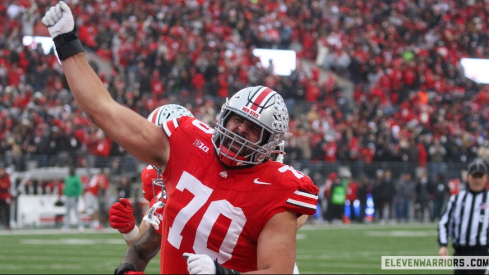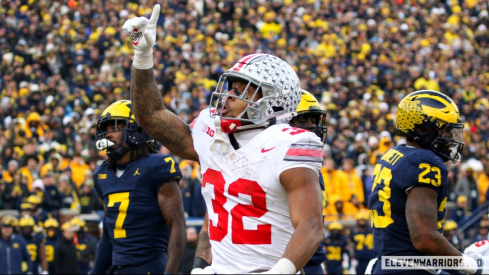
An already inexperienced Ohio State defense was so decimated by injuries and suspensions against Buffalo that it is almost difficult to draw conclusions from the performance.
Despite missing its few experienced players for much of the contest, the Buckeye defense held its own. Though it may have been dinked and dunked once Ryan Shazier left with cramps, the defense only allowed one non-turnover created touchdown and had a goal line stand.
The Ohio State defense's young starters have ample room to progress, and the unit should only improve with the return of Bradley Roby and others this weekend against San Diego State.
We'll explore how the defense played significant stretches of the Buffalo game without its two best players, take a closer look at Ohio State's new dime formation, examine how the cover 4 shell formation exposed the Buckeyes to underneath throws to the wide-side flat and more.
Battered and Bloodied
Other than Braxton Miller, perhaps no players are more important to the 2013 team than Bradley Roby and Ryan Shazier. Not only are they All-American candidates at cornerback and linebacker, but the drop-off between them and their back-ups is sizeable.
Against Buffalo, however, a defense that is replacing seven starters played for significant stretches without Roby and Shazier – as well as CJ Barnett. This turned the one area of returning strength – defensive back – into a weakness. As a result the Ohio State coaching staff sought to keep their play calling fairly basic. Against Buffalo's base 11 personnel (3 WR, 1 TE, 1 RB), the Buckeyes largely employed their 4-2-5 nickel over defense. The defensive line plays an over to the field, meaning that the viper (Noah Spence) and 3 technique (Michael Bennett) play to the wide side, while the nose (Joel Hale) and 5 technique (Adolphus Washington) play to the boundary. The back seven aligns their strength to the wide side. The field corner (Armani Reeves), star (Tyvis Powell), strong safety (Corey Brown), and mike (Curtis Grant) go to the field, while the boundary corner (Doran Grant), free safety (Christian Bryant) and will (Shazier) play to the field's short side.

On first and second down the Buckeyes primarily used cover 4 or cover 1. Ohio State did mix in a noticeable amount of run blitzing, often coming in the form of a single blitzer from the corner or nickel position. The Buckeyes generally played cover 1 behind the blitz.
Diming It
On third and long, the Buckeyes unveiled their new dime formation.

The Buckeyes' dime is a variation of their nickel formation. Corey Brown simply comes in at Mike linebacker. From dime, the Buckeyes generally played cover 2 or cover 3 (though the Buckeyes did run one man blitz from dime). For instance, the Buckeyes played dime cover 2 on Ron Tanner's interception.

Look for the Ohio State defense to continue to use dime in must-pass situations, with the Buckeyes likely being more varied in their schemes going forward.
DINK, DINK, DINK
The Buckeyes' cover 4 shell left them vulnerable to underneath throws to the wide-side flat. Every coverage has a weakness and cover 4 is exposed in that area. By playing cover 4, a defense to some extent concedes these short throws, counts on its corner to make the tackle, and seeks to force an offense to string together completions to drive the field.
Buffalo took the Buckeyes up on this dare, gaining most of its yards on wide receiver screens and quick outs. And, it should be noted, Buffalo had difficulty stringing together such drives.
A cover 4 defense does not need to simply concede these yards, however. A cover-4 corner can quickly close on such throws. The defense can also make what Nick Saban terms a "Meg" call. This puts the corner in man coverage against the outside receiver, allowing that corner to play the receiver more aggressively. In addition, the player responsible for the wide side flat – Ohio State's nickel, aka star – can defeat the block on a wide receiver screen and make the tackle.
This is where Ohio State's inexperience came into play. Armani Reeves' was inconsistent in his first start. He played soft coverage, likely out of a concern about getting beat deep. Ohio State's defensive coaches were likely uninterested in putting Reeves into Meg coverage. Going forward, Roby can be far more aggressive in attacking the flat. Star Tyvis Powell was solid, but did not come in and blow up wide receiver screens as we have seen from previous nickels. Buffalo was thus able to have some success with short, underneath throws.
CLosing Daylight
Buffalo's drives were limited early by their inability to run the football. The primary cause for their inability was Ryan Shazier. The difference between Shazier and the other Buckeye linebackers is noticeable. Shazier quickly sheds blocks and aggressively closes the hole.
It is no surprise that the Bulls began having more success running the football once Shazier left with cramps. That is not to say the other linebackers performed poorly. For his first college game Trey Johnson showed flashes as will as Shazier's backup. Curtis Grant demonstrated noticeable improvements. Grant's recognition was still slow at times and he did not take the crisp angles Shazier did. But Grant was around the ball and was a sure tackler. He showed that with increased repetitions he can play well at mike linebacker and has likely locked down the position.
Manning the Line
Buffalo also provided the first extended action for the Buckeyes' inexperienced defensive line. The new starters largely acquitted themselves well. Concerns were raised about the lack of consistent pass rush, but Buffalo provided little opportunity to rush the passer, as the Bulls threw almost exclusively quick from shotgun.
Noah Spence established himself at viper. In addition to a sack he controlled the line of scrimmage. Spence must continue to work upon his pass rush technique rather than relying upon his athleticism. Adolphus Washington set contain well, but had stretches where he was rather quiet. Michael Bennett and Joel Hale maintained the point of attack inside. Bennett also demonstrated his pass rushing ability from 3 technique. The Buckeyes still miss Tommy Schutt as an interior run stopper, particularly for the depth needed at those positions.
Perhaps the most pleasant surprise was Joey Bosa in his first extended action. Bosa demonstrated his strength controlling his gap, while also showing a nose for the football. Bosa and Washington cannot play an entire game. But with depth so thin, the defensive coaching staff may perhaps play Bosa and Washington simultaneously, with Washington moving inside to 3 technique.
Call in the Cavalry
Fortunately for Ohio State, Roby, Barnett and Shazier will hopefully be available for the remainder of the season. With Roby at boundary corner, Doran Grant can move to field corner. Grant played well against Buffalo, attacking the underneath throws that bedeviled Reeves. This should limit teams' ability to exploit the Buckeyes underneath.
Barnett provides the Buckeyes leadership as well as a run stopper in force support. Roby and Barnett's return allows the defense to play a greater variety of coverages and provides more freedom to Ohio State's front seven. With Roby, Barnett, Christian Bryant and Grant the Buckeyes have one of the best defensive backfield's in the country. As such, some of the mistakes against Buffalo will hopefully be corrected by the return of multiple key Buckeye defenders.

